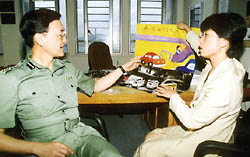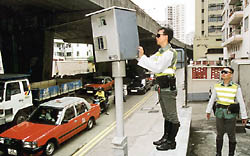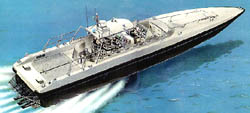



















| ||
 "Changing driving habits and attitudes will not happen over night - which is why we should be doing more, now," says CSP Traffic, Patrick Lai Pak-hay discussing road safety strategies with CIP Maggie Chan | ||
|
EVEN though the first quarter of 1998
saw a reduction in traffic accidents for the first time in all five police regions of Hong Kong
underlining a downward trend that has continued over the past few years, CSP Traffic Patrick
Lai Pak-hay sees a long and winding road ahead for Hong Kong drivers unless attitudes towards
road safety are improved.
"Hong Kong commercial and private drivers may be trained on the technical aspects of driving, but they need to be re-educated on aspects of road safety and to improve their reckless attitudes," says CSP Lai, who points to Hong Kong drivers' bad habit of speeding (closely followed by tailgating) as the main cause of traffic accidents - many fatal. "We issued 200,000 speeding tickets in 1997 - and those are only the one's who were caught! Yet we haven't resolved the speeding problem. It's time to take another tact. At present road safety in Hong Kong is still focused solely on police involvement. But enforcement should be the last resort. Driver education and publicity over the long term is the key," continued CSP Lai, who along with CIP Maggie Chan, Road Safety Traffic HQ, recently attended the 63rd National Road Safety Congress held in the UK at Blackpool, whose theme this year was "Drivers: Licensed to Kill?". It was an invaluable opportunity to discuss and witness innovations relating to road safety with a view to applying some on Hong Kong's mean streets. "According to the Congress' organiser, the Royal Society for the Prevention of Accidents, the title was chosen because of the belief that a review of driver licensing and testing regimes is necessary," said CIP Chan. "More than 90 per cent of all traffic accidents have a driver error element. This is true not only in the UK, but also in Hong Kong. In the UK they are looking seriously at the process by which drivers are trained and tested with the idea of providing an extended period of carefully structured driving experience, supported by more effective training and testing, and encouraging continual development of driving ability and attitudes through post-test training and driver improvement courses." The Road Safety Congress also encouraged debate on the many ways in which the concept "driving should be seen as a privilege and not a right" could be achieved, the likely effects of new technology on drivers, the role of Road Safety Officers in promoting driver development, and the duties of employers in proactively reducing the risks that result from employees who drive for a living. Says CIP Chan: "For many years the Hong Kong Police Force has spearheaded the organisation of Road Safety Campaigns and has been taking a leading role in road safety education. Most of the road safety activities in the UK, however, are co-ordinated by Road Safety Officers of the local government (non police officers). Large companies like public transport operators also recruit their own Road Safety Officers to help promote driving safety - an area for improvement in Hong Kong." "In addition," commented CSP Lai, "non-governmental organisations like the Royal Society for the Prevention of Accidents do a lot of research and projects into aspects of road safety - an area in which Hong Kong is very weak." Another practice currently being tested in the UK that CSP Lai considers a useful idea for Hong Kong is the Driver Improvement Scheme, which is designed to re-educate drivers who have been stopped for "driving without reasonable consideration for other road users". It is a direct alternative to a court appearance, possible conviction, fine, demerit points, and is based on the premise that it is in the public interest to rectify a fault rather than punish the transgressor. Says CSP Lai: "The beauty of this scheme is that offenders (who must pay for their participation in the scheme in lieu of a fine or points) are brought back to be re-educated on all aspects of road safety while learning to rectify their reckless attitudes. Recently I met with Taxi and Bus Drivers Association representatives who welcomed the scheme." While in the UK, CSP Lai and CIP Chan also visited their counterparts in London's Metropolitan Police and exchanged views on a number of issues relating to traffic policing including the use of helicopters in road surveillance, their speed camera and red light camera projects - and their subsequent success in gradually shaping driver behaviour. "There's about 700 box radar traps in the UK - 500 in the greater London vicinity, and over 50 cameras," said CSP Lai. "We were told that money invested in automating this system was recovered in a couple of years. They say they are now enjoying a high return on their expenditure. It is a very cost effective and a win/win exercise. They are currently looking at combining 3-way automation that includes traffic CCTV, red-light jumping cameras and speed radar in one unit. But the real point has been the reduction in speeding and traffic accidents. "In Hong Kong, we've got 10 speeding cameras, five radar boxes and 13 red light cameras. They've proved very effective in reducing speeding and red-light jumping related accidents in their areas of use - but we need more. Visible cameras and boxes act as a deterrent, while full automation frees up manpower," he emphasises. | ||
|
"Then the message is simple," adds CIP Chan. "If you speed you will be caught." "Constant road safety education and automation are key to reducing accidents on the roads of Hong Kong," concludes CSP Lai. "Traffic accidents may be going down in Hong Kong, but one death is too many. That's the point." |  Hong Kong traffic officers activating a red light-jumping camera |
| |
 What the interceptor will look like when delivered to the ASTF, whose officers took a substantial hand in its design | THE design and construction of Marine Region's five new power boats - interceptors for the Anti Smuggling Task Force (ASTF) - is proceeding on schedule. The designers and builders of the boats are very experienced and highly reputable in the construction of customised fast pursuit craft and have designed and built many competition class power boats. |
|
The Interceptors have been designed specifically for the ASTF to provide counter-measures against the use of dai feis in smuggling. They will feature designs commonly found on power boats used by other law enforcement agencies around the world to enable high speed applications. Three officers from Marine Region, CIP A C Currie of Support Bureau MAR HQ, and Ssgt Sammy Leung and Sgt Kelvin Ng, both of ASTF, recently travelled to Rotterdam in Holland where the interceptors are being constructed and together with Danny Woo of COMMS Branch and two naval architects from Marine Department, they examined a full-size wooden mock up of the cockpit design layout making over fifty suggestions to improve the layout and ergonomic designs. The input from the ASTF officers, who are highly experienced in small boat handling, was extremely important in ensuring that the boats meet operational requirements. The interceptors are constructed of aluminium and are powered by petrol engines of a special design to enable them to travel at a top speed in excess of 60 knots fully loaded. Although the use of dai feis in smuggling has greatly decreased in recent years as a result of the operational success of the ASTF, the new Interceptors will be an effective deterrent in case of a resurgence of these activities. | |

